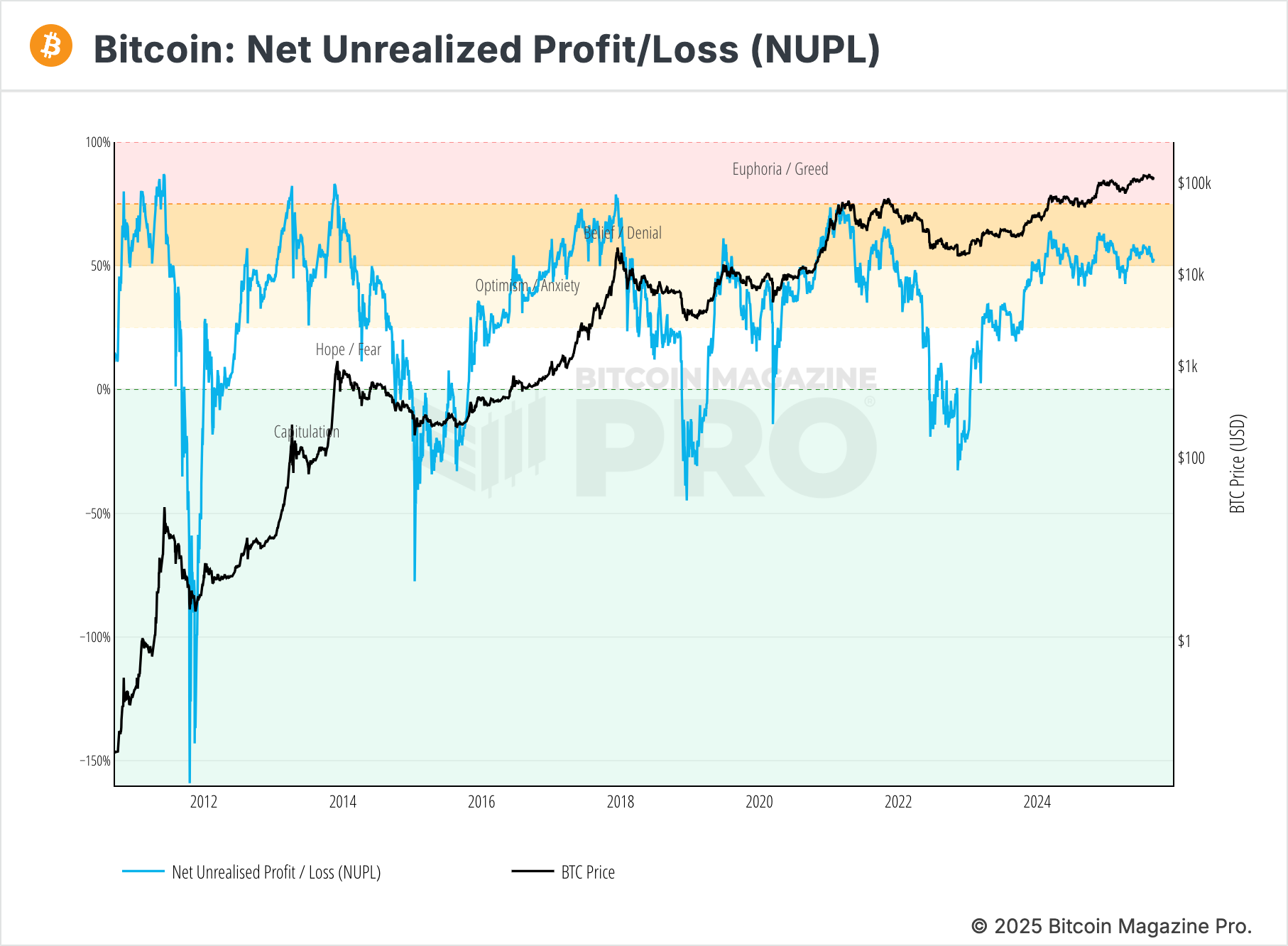What Is NUPL?
NUPL estimates the net unrealised profit or loss of the circulating supply by comparing the market value of coins with the price at which they last moved on-chain. Positive values indicate the network holds net unrealised profit; negative values indicate net unrealised loss.
How Is NUPL Calculated?
- Unrealised Profit = coins currently priced above their last move price.
- Unrealised Loss = coins currently priced below their last move price.
- NUPL = (Unrealised Profit − Unrealised Loss) ÷ Market Cap.
NUPL is dimensionless and typically presented as a value between −1 and +1.
Why NUPL Matters
- Captures crowd positioning: how much of supply sits in profit versus loss.
- Frames emotional regimes during cycles without relying on headlines.
- Complements valuation tools by showing holder positioning beneath price.
Interpreting the NUPL Zones
Conventions vary, but these zones are commonly used:
- < 0.0: capitulation and deep stress.
- 0.0–0.25: disbelief to hope; early recoveries.
- 0.25–0.5: optimism to belief; broad participation rises.
- 0.5–0.75: euphoria risk builds; distribution becomes more likely.
- > 0.75: late-cycle risk historically.

This chart displays NUPL with colour-coded zones to highlight cycle phases and turning areas.
Practical Reads
- Zone transitions: sustained moves from < 0.25 into 0.25–0.5 often signal healthier advances; sharp jumps into > 0.5 demand caution and confluence.
- Retests: pullbacks that hold within a lower zone can offer continuation; slipping zones warns of fading participation.
- Divergences: price making higher highs while NUPL stalls can hint at thinning participation; rising NUPL while price ranges can indicate quiet accumulation.
Use NUPL With Confluence
Pair NUPL with:
- Realised Price Bands (Market/LTH/STH): confirm whether participation is supported by rising cost basis.
- SOPR / Realised PnL: check if profits are being taken or absorbed.
- Dormancy/CDD: see whether older coins are driving the shift.
Common Pitfalls

- Treating a single zone as a trigger; zones migrate as liquidity evolves.
- Ignoring timeframe; weekly aggregates reduce noise versus daily flips.
- Reading NUPL in isolation without checking spending behaviour and cost-basis ladders.
A Simple Workflow You Can Reuse
- Open NUPL on a weekly chart; note the current zone and direction.
- Cross-check Market/LTH/STH Realised Price.
- Confirm with aSOPR and Realised PnL for behaviour.
- Scan Dormancy/CDD to see if older supply is participating.
- Decide: advancing participation with support, or euphoria risk with distribution.
FAQ
Is high NUPL always bearish?
No. High readings can persist while realised cap and cost basis rise. Risk increases when euphoria zones align with distribution signals elsewhere.
Which timeframe should I use?
Weekly for cycle reads. Use daily only for timing once a clear regime is established.
How does NUPL differ from MVRV?
MVRV compares market and realised caps at a network level; NUPL focuses on the share of supply in profit or loss. They often agree but highlight different angles.
If this helped you map market phases cleanly, join Alpha Insider for NUPL zone guides, cycle case studies, and weekly timing windows. Fewer mistakes, cleaner execution, more conviction.
The Markets Unplugged members get:
➡️ Kairos timing windows to plan entries before the crowd moves
➡️ A full DCA Targets page with levels mapped for this cycle
➡️ Exclusive member videos breaking down charts in plain English
➡️ A private Telegram community where conviction is shared daily
➡️ A dedicated Bitcoin On-Chain Analysis page with regularly updated analysis and monthly reports (MVRV, SOPR, NUPL, Puell, URPD)
It’s the full playbook.














Discussion